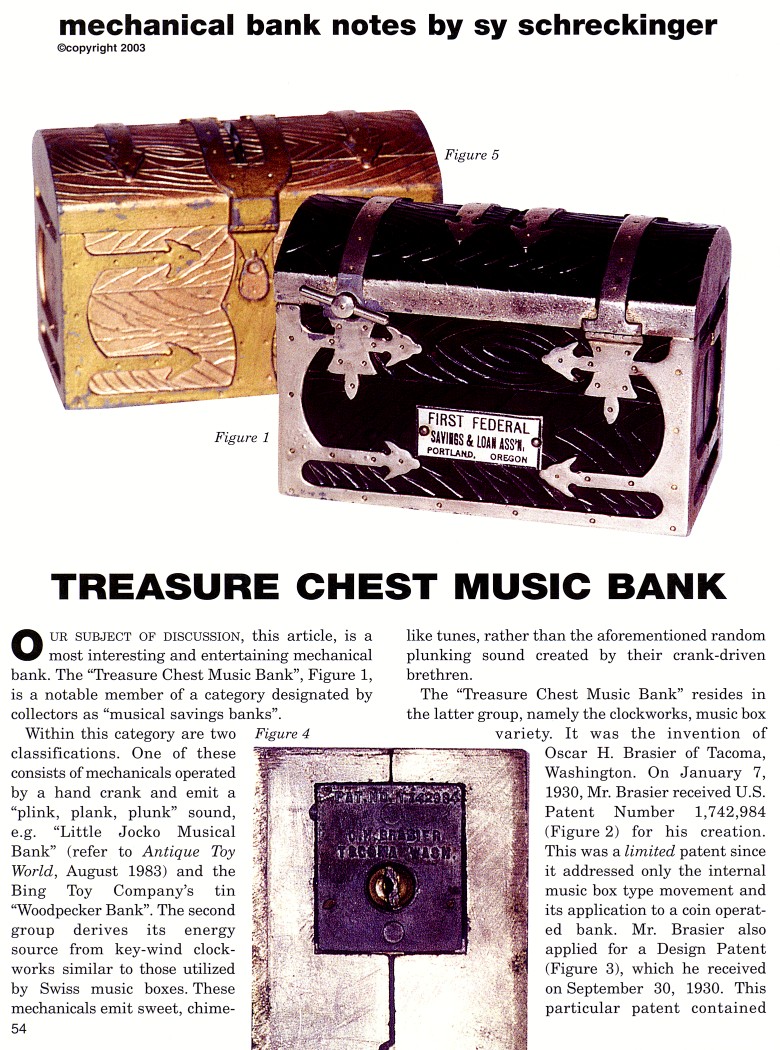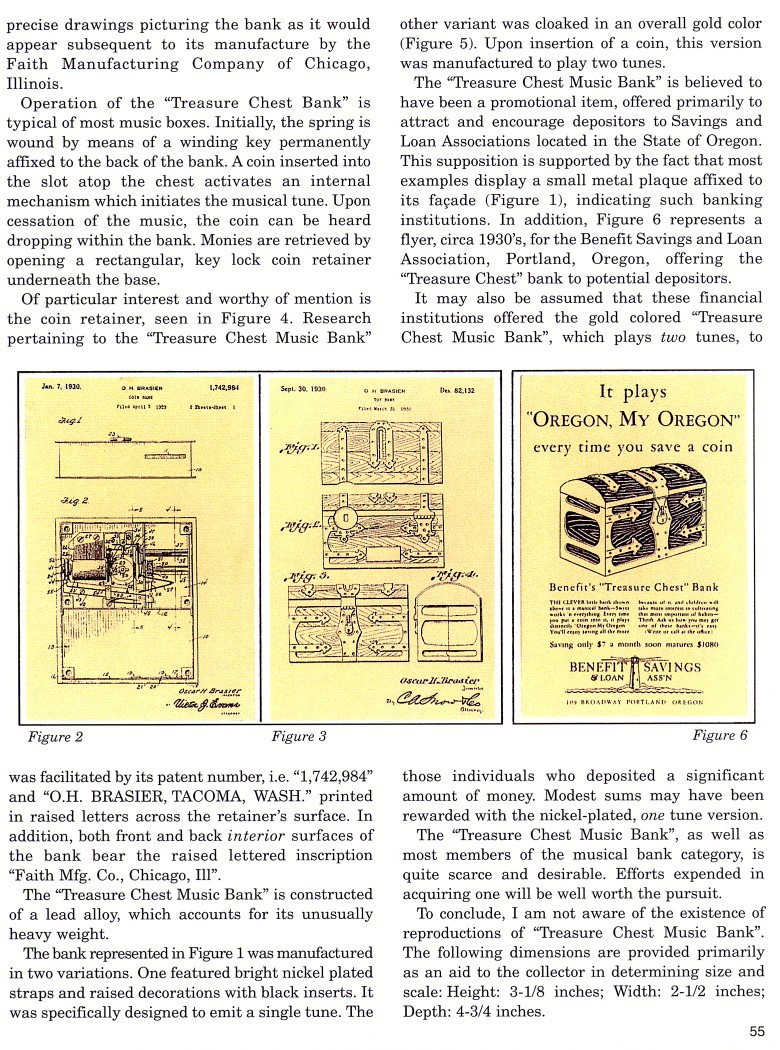|
Treasure Chest Music
Bank
by Sy Schreckinger – ANTIQUE TOY WORLD Magazine – November, 2003
Our subject of discussion, this article, is a
most interesting and entertaining mechanical bank. The "Treasure Chest
Music Bank", Figure 1, is a notable member of a category designated by
collectors as "musical savings banks".
Within this category are two classifications. One of these consists
of mechanicals operated by a hand crank and emit a "plink, plank, plunk"
sound, e.g. "Little Jocko Musical Bank" (refer to Antique Toy World,
August 1983) and the Bing Toy Company's tin "Woodpecker Bank". The second
group derives its energy source from key-wind clockworks similar to those
utilized by Swiss music boxes. These mechanicals emit sweet, chime-like
tunes, rather than the aforementioned random plunking sound created by
their crank-driven brethren.
The "Treasure Chest Music Bank" resides in the latter group, namely
the clockworks, music box variety. It was the invention of Oscar H. Brasier of
Tacoma, Washington. On January 7, 1930, Mr. Brasier received U.S. Patent
Number
1,742,984 (Figure 2) for his creation. This was a limited patent
since it addressed only the internal music box type movement and its
application to a coin operated bank. Mr. Brasier also applied for a Design
Patent (Figure 3), which he received on September 30, 1930. This
particular patent contained precise drawings picturing the bank as it
would appear subsequent to its manufacture by the Faith Manufacturing
Company of Chicago, Illinois.
Operation of the "Treasure Chest Bank" is typical of most music
boxes. Initially, the spring is wound by means of a winding key
permanently affixed to the back of the bank. A coin inserted into the slot
atop the chest activates an internal mechanism which initiates the musical
tune. Upon cessation of the music, the coin can be heard dropping within
the bank. Monies are retrieved by opening a rectangular, key lock coin
retainer underneath the base.
Of particular interest and worthy of mention is the coin retainer,
seen in Figure 4. Research pertaining to the "Treasure Chest Music Bank"
was facilitated by its patent number, i.e. "1,742,984" and "O.H. BRASIER,
TACOMA, WASH." printed in raised letters across the retainer's surface. In
addition, both front and back interior surfaces of the bank bear the
raised lettered inscription "Faith Mfg. Co., Chicago, Ill".
The "Treasure Chest Music Bank" is constructed of a lead alloy, which
accounts for its unusually heavy weight.
The bank represented in Figure 1 was manufactured in two variations.
One featured bright nickel plated straps and raised decorations with black
inserts. It was specifically designed to emit a single tune. The other
variant was cloaked in an overall gold color (Figure 5). Upon insertion of
a coin, this version was manufactured to play two tunes.
The "Treasure Chest Music Bank" is believed to have been a
promotional item, offered primarily to attract and encourage depositors to
Savings and Loan Associations located in the State of Oregon. This
supposition is supported by the fact that most examples display a small
metal plaque affixed to its facade (Figure 1), indicating such banking
institutions. In addition, Figure 6 represents a flyer, circa 1930's, for
the Benefit Savings and Loan Association, Portland, Oregon, offering the
"Treasure Chest" bank to potential depositors.
It may also be assumed that these financial institutions offered the
gold colored "Treasure Chest Music Bank", which plays two tunes, to those
individuals who deposited a significant amount of money. Modest sums may
have been rewarded with the nickel-plated, one tune version.
The "Treasure Chest Music Bank", as well as most members of the
musical bank category, is quite scarce and desirable. Efforts expended in
acquiring one will be well worth the pursuit.
To conclude, I am not aware of the existence of reproductions of
"Treasure Chest Music Bank". The following dimensions are provided
primarily as an aid to the collector in determining size and scale:
Height: 3-1/8 inches; Width: 2-1/2 inches; Depth: 4-3/4 inches.
Addendum: (from
January, 2004) Refer to Antique Toy World article "Treasure Chest
Music Bank", November 2003. My thanks to fellow mechanical bank collector,
Frank Kidd. He has informed me that his collection includes several
different sizes, casting, and color variants of the "Treasure Chest Music
Bank" that were not described within my article. A future follow-up
article is intended to discuss all of these.
Acknowledgement: Refer to Antique Toy World article "Treasure
Chest Figure 7 Music Bank",
November 2003. The banks featured in that
article are from the collection of Robert E. Weiss.
|


